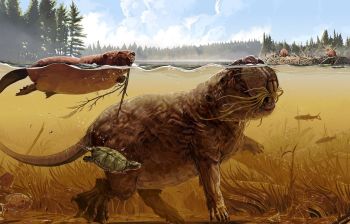Difference between revisions of "Beaver"
Tao alexis (talk | contribs) |
Tao alexis (talk | contribs) |
||
| (15 intermediate revisions by the same user not shown) | |||
| Line 33: | Line 33: | ||
| '''[[Damage (hit points)|Damage]]''' || bite (1-6) || claw (1-6); bite (3-12) | | '''[[Damage (hit points)|Damage]]''' || bite (1-6) || claw (1-6); bite (3-12) | ||
|- | |- | ||
| − | | '''Special Attack''' || [[Calling|tail slap]] || [[Deafness (condition)|deafness]] | + | | '''Special Attack''' || [[Calling|tail slap]] || tail slap & [[Deafness (condition)|deafness]] |
|} | |} | ||
| Line 43: | Line 43: | ||
'''Common beavers''' possess stout bodies with large heads, chisel-like incisors and coats of brown or gray fur. Their front paws resemble human hands, while their hind limbs are webbed; they possess a flat, scaly tail. These distinctive attributes equip them exceptionally well for thriving in a habitat that combines land and water. | '''Common beavers''' possess stout bodies with large heads, chisel-like incisors and coats of brown or gray fur. Their front paws resemble human hands, while their hind limbs are webbed; they possess a flat, scaly tail. These distinctive attributes equip them exceptionally well for thriving in a habitat that combines land and water. | ||
| − | [[File:Beaver.jpg|left| | + | [[File:Beaver.jpg|left|385px|thumb]] |
| + | |||
== Behaviour == | == Behaviour == | ||
| − | The ponds they create typically reach depths of 10 to 12 feet and span hundreds of feet in width. Beaver families typically consist of an adult male and female, along with their young kits and yearlings. Offspring may either remain in the same beaver pond as their parents or construct adjacent ponds that share water sources. In the absence of disturbances, entire beaver "communities" can emerge, covering areas that extend up to two miles in diameter. They're generally social animals that live in family groups, tending to cooperate in building and maintaining their dams and lodges. | + | The ponds they create typically reach depths of 10 to 12 feet and span hundreds of feet in width. The ponds improve water quality by trapping sediments and pollutants the increased water availability promoting the growth of various plants that serve as a valuable food source. |
| + | |||
| + | Beaver families typically consist of an adult male and female, along with their young kits and yearlings. Offspring may either remain in the same beaver pond as their parents or construct adjacent ponds that share water sources. In the absence of disturbances, entire beaver "communities" can emerge, covering areas that extend up to two miles in diameter. They're generally social animals that live in family groups, tending to cooperate in building and maintaining their dams and lodges. | ||
Blending seamlessly into the underbrush, often spotting a character as they traverse through the wooded terrain long before being noticed themselves, makes it exceedingly difficult to catch them by surprise. Additionally, their [[Swimming (sage ability)|swimming]] skills allow them to swim 4 [[Combat Hex|hexes]] per [[Action Points|action point]]. The entrance to their lodge is exclusively accessible from beneath the waterline, requiring passage through a vertical doorway beneath the surface. | Blending seamlessly into the underbrush, often spotting a character as they traverse through the wooded terrain long before being noticed themselves, makes it exceedingly difficult to catch them by surprise. Additionally, their [[Swimming (sage ability)|swimming]] skills allow them to swim 4 [[Combat Hex|hexes]] per [[Action Points|action point]]. The entrance to their lodge is exclusively accessible from beneath the waterline, requiring passage through a vertical doorway beneath the surface. | ||
| Line 55: | Line 58: | ||
== Castoroides == | == Castoroides == | ||
| − | + | '''Casteroides''', commonly known as giant beavers, re known for their massive size and distinct characteristics. As large as a small bear, they're much more able to traverse over land with ease. Resembling their smaller counterparts, their forelimbs are more elongated and their jaws more robust. They still live near bodies of water and use their strong, chisel-like teeth to cut down trees to build dams. | |
| − | '''Casteroides''' | + | |
| + | [[File:Casteroides c.jpg|left|350px|thumb]] | ||
| + | Some sources suggest that these creatures may possess a higher level of [[Intelligence (ability stat)|intelligence]] than traditionally believed, this remains a topic of ongoing investigation. Nevertheless, they undoubtedly demonstrate greater cognitive abilities than their common counterparts. Casteroides have been observed engaging in chittering communication and displaying a degree of organization when confronting outsiders. | ||
| + | |||
| + | Additionally, these creatures are exceptionally confrontational, actively pursuing and assaulting intruders to expel them from their territory, especially during the breeding season. | ||
| − | + | It's evident that they employ their tail slap to signal their kindred to join in coordinated attacks. There's a prevailing belief that casteroides are cognizant of the impact of their tail slap and deliberately time it to their advantage. | |
| + | |||
| + | === Advantages === | ||
| + | '''Tail slap & deafness.''' The resounding tail slap of a casteroides possesses a shocking, ear-splitting quality that can be heard from a quarter-mile away. Within 120 ft., it's disruptive nature is capable of shattering a spellcaster's [[Spellcasting|concentration]], effectively sabotaging the casting of spells. | ||
| − | + | Those within 40 ft., or eight hexes, must make a [[Saving Throws|save against magic]] to avoid a temporary '''[[Deafness (condition)|deafness]]''' lasting for 2 to 8 [[Combat Round|rounds]]. While deaf, characters are so disoriented that [[Roll to Hit|rolls to hit]] with [[Weapons List|weapons]] suffer a -2 penalty. | |
| − | See [[Bestiary]] | + | See also,<br> |
| + | [[Animal Summoning I (spell)]]<br> | ||
| + | [[Bestiary]] | ||
| − | [[Category: | + | [[Category: Reviewed]] |
Latest revision as of 20:43, 27 October 2023
| Detail | Common beaver | Castoroides |
|---|---|---|
| Species | rodent | |
| No. Appearing | 2-20 | 2-12 |
| Behaviour | social lodge | |
| Range | taiga, woodland | |
| Size | 24 in. long | 7 ft. long |
| Weight | 55 lbs. | 250 lbs. |
| Intelligence | 1 | 3 |
| Armour Class | 7 | 6 |
| Hit Dice | 1 | 4 |
| Action Points | 4 | 4 |
| Max. Stride | 3 (4 in water) | 5 (6 in water) |
| THAC0 | 20 | 18 |
| Hp/Die | d4 | d8 |
| Attack Form | 1: bite | 2: claw; bite |
| Damage | bite (1-6) | claw (1-6); bite (3-12) |
| Special Attack | tail slap | tail slap & deafness |
Beavers are nocturnal, semi-aquatic rodents renowned for their skill in constructing dams, canals and lodges. They carefully select well-watered habitats to establish their colonies, reshaping the environment by felling trees, forming expansive ponds and canals, and eventually transforming low-lying areas into sizable lakes. This behavior poses a significant challenge and source of frustration for those seeking to navigate through areas inhabited by beavers.
Their fur is highly prized for its exceptional warmth, durability and remarkable ability to repel water. Trappers and settlers in many parts of the world engage in the hunting and trapping of beavers to obtain their valuable pelts, which are in great demand, primarily for clothing. The desire for beaver fur is so intense that it's driving the exploration of North America by Europeans.
Common Beaver
Common beavers possess stout bodies with large heads, chisel-like incisors and coats of brown or gray fur. Their front paws resemble human hands, while their hind limbs are webbed; they possess a flat, scaly tail. These distinctive attributes equip them exceptionally well for thriving in a habitat that combines land and water.
Behaviour
The ponds they create typically reach depths of 10 to 12 feet and span hundreds of feet in width. The ponds improve water quality by trapping sediments and pollutants the increased water availability promoting the growth of various plants that serve as a valuable food source.
Beaver families typically consist of an adult male and female, along with their young kits and yearlings. Offspring may either remain in the same beaver pond as their parents or construct adjacent ponds that share water sources. In the absence of disturbances, entire beaver "communities" can emerge, covering areas that extend up to two miles in diameter. They're generally social animals that live in family groups, tending to cooperate in building and maintaining their dams and lodges.
Blending seamlessly into the underbrush, often spotting a character as they traverse through the wooded terrain long before being noticed themselves, makes it exceedingly difficult to catch them by surprise. Additionally, their swimming skills allow them to swim 4 hexes per action point. The entrance to their lodge is exclusively accessible from beneath the waterline, requiring passage through a vertical doorway beneath the surface.
Beavers are not known for being aggressive or engaging in active fighting with each other. Encountered out of water, they can become defensive if they feel threatened or cornered. Beavers are expressly made uncomfortable by dogs, with such interactions being unpredictable.
Advantages
Tail slap. As a warning signal to alert other beavers, they slap their tails on the water. The sound is loud and hollow, carrying for at least 180 feet in a quiet wood. In remote regions, trappers and hermits rely on beavers to act as sentinels, alerting them to the presence of unfamiliar individuals or creatures in the vicinity. Over time, beavers become accustomed to the human presence they encounter daily. Trappers establish themselves in these areas and place traps, given the value of beaver pelts. However, experienced trappers exercise caution, ensuring they only harvest a single pelt from each beaver family.
Castoroides
Casteroides, commonly known as giant beavers, re known for their massive size and distinct characteristics. As large as a small bear, they're much more able to traverse over land with ease. Resembling their smaller counterparts, their forelimbs are more elongated and their jaws more robust. They still live near bodies of water and use their strong, chisel-like teeth to cut down trees to build dams.
Some sources suggest that these creatures may possess a higher level of intelligence than traditionally believed, this remains a topic of ongoing investigation. Nevertheless, they undoubtedly demonstrate greater cognitive abilities than their common counterparts. Casteroides have been observed engaging in chittering communication and displaying a degree of organization when confronting outsiders.
Additionally, these creatures are exceptionally confrontational, actively pursuing and assaulting intruders to expel them from their territory, especially during the breeding season.
It's evident that they employ their tail slap to signal their kindred to join in coordinated attacks. There's a prevailing belief that casteroides are cognizant of the impact of their tail slap and deliberately time it to their advantage.
Advantages
Tail slap & deafness. The resounding tail slap of a casteroides possesses a shocking, ear-splitting quality that can be heard from a quarter-mile away. Within 120 ft., it's disruptive nature is capable of shattering a spellcaster's concentration, effectively sabotaging the casting of spells.
Those within 40 ft., or eight hexes, must make a save against magic to avoid a temporary deafness lasting for 2 to 8 rounds. While deaf, characters are so disoriented that rolls to hit with weapons suffer a -2 penalty.
See also,
Animal Summoning I (spell)
Bestiary

